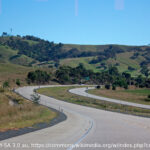Wildlife Crossings
Wildlife crossings, also known as green bridges, ecoducts and overpasses, and including structures such as fish ladders and green rooves, allow wild animals to follow their traditional routes without having to cross roads. Every year huge numbers of wild animals are killed on the roads worldwide as they migrate and forage and try to escape from danger. Wildlife crossings have had a very positive impact, allowing animals to move around safely. Here we look at a few examples.
The Trans-Canada Highway wildlife crossings
A stretch of the Trans-Canada highway runs through Banff National Park. This was a deadly stretch of road for Canada’s wildlife, particularly elk. Since the 1980s at least 38 underpasses and six green bridges have been built, and the project has inspired similar ecoducts all over the world. Ironically the project began when the road was expanded, which increased concerns about the danger to motorists.
Increasing concern for grizzly bears and wolves led to the creation of more overpasses in the 1990s. The real game changer was monitoring use of the crossings. Monitoring revealed a staggering 86% decrease in collisions between deer and cars. The team at Montana University designing the monitoring devised a system to snag hair from pssing animals, which allowed them to identify the species and sex of each animal as well as establishing identities. There’s a long and very interesting article about the Banff National Park crossings here.
Wildlife crossing tourism

In Australia green bridges have become a tourist attraction. There’s even a guide book to them, specifically 57 site along the Bruce Highway, Pacific Highway and Hume Highway. The guidbeook’s author, Dr Brendan Taylor, is a wildlife ecologist. He’s spent decades designing the crossings and monitoring their use.
Wildlife crossings aren’t just land bridges. Australian ones include glider poles. These look just like telegraph poles at the side of the road. Instead of having wires strung between them, they’re there for flying possums. The flying possums leap, or fly, from one to the other across the road, safely avoiding cars and trucks. You can see an example of those at Holbrook on the NSW South West Slopes. Other species benefitting from specially designed passes include pygmy possums and wombats in Victoria and the endangered giant barred frog in New South Wales.
In a country prone to wildfires ecoducts can play a crucial role in allowing animals to flee to safety.
The longest ecoduct in the world
Completed in 2006, the Natuurbrug Zanderij Crailoo in Hilversum in the Netherlands is the longest wildlife overpass in the world. Meaning “sand quarry nature bridge at Crailo” the pass is 50 meters wide and nearly a kilometre long. It crosses over a railway line, sports complex, the N524 road and business park.
Deer, wild boar and badgers, specifically the endangered European badger, use this overpass to get to other wooded areas. The passes have been designed to fit in with the surrounding landscape.
Wildlife crossing in Estonia

In 2013 Estonian authorities started building an ecoduct over a section of the Tallinn-Tartu highway. The bridge itself is beautiful as well as useful.
It was the first green bridge in Estonia. As well as being planted with trees and undergrowth, the bridge has a fence to protect animals from the noise and headlights of passing vehicles. This ecoduct isn’t aimed at any one animal and is suitable for all sorts of creatures. Estonia has populations of the Eurasian lynx, moose, brown bears and deer among many other species. Estonian authorities are planning more wildlife crossings.
Accidental wildlife crossings
Castilla La Mancha is in central Spain. In the early 1990s discovered that two flyovers over a high speed railway in Castilla La Mancha and culverts under it were being used by smaller mammals including brown hare, red fox and the common genet. Studies allowed researchers to better design these overpasses and culverts to attract more animals. This included varying the width of the passes and adding fencing. You can read more about the study here.



